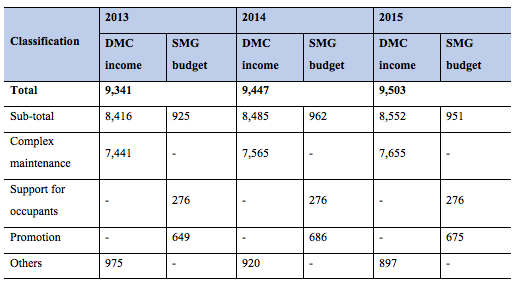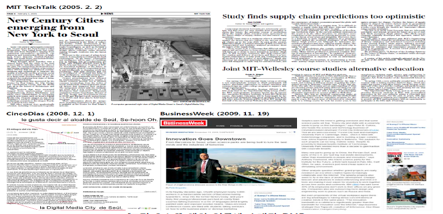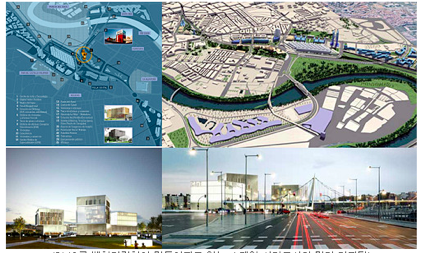بناء المدينة الاعلامية الرقمية في سانجام سيول (DMC)
Policy Overview
The Sangam Digital Media City (DMC) was created as part of the larger Millennium City project in the Sangam-dong district of Seoul, 4 miles (7 km) from the central business district. Conceived as an industrial cluster of world-class digital media and entertainment companies, it now develops, produces and disseminates cutting-edge media contents − where the environment and technology, culture and industry, investment and innovation, converge and blend amazingly well.
The Sangam Digital Media City (DMC) was created as part of the larger Millennium City project in the Sangam-dong district of Seoul, 4 miles (7 km) from the central business district. Conceived as an industrial cluster of world-class digital media and entertainment companies, it now develops, produces and disseminates cutting-edge media contents − where the environment and technology, culture and industry, investment and innovation, converge and blend amazingly well.
Background
Environmental degradation due to the landfill in Nanjido
Nanjido was an island where most of Seoul’s domestic wastes were dumped for 15 years from 1978. Household wastes collected from the city had piled up to form a mountain of trash weighing 120 million tons reaching a height of 95 meters and length of two kilometers. In 1993, the island, saturated with wastes, was closed completely, Seoul’s domestic wastes, since then, have been taken to the landfill in Gimpo instead. However, once contaminated, the area continued to suffer from environmental issues, and discussions on projects for regeneration of the area continued. Among them were the ‘early development plan’ and ‘stabilized long-term development plan’. While the former contends to dig up the trash right way and developed the site into a residential or commercial district, the latter argues to develop it based on a long-term plan; first stabilize the site by installing antipollution facilities and create a park for citizens, then proceed with the site development in steps.
Adopted the long-term stabilization plan, a citizens’ park was created
After deliberation on how best to utilize the former landfill site, the Seoul Metropolitan Government opted for the long-term development plan. As the ground rule was to restore the environment while keeping the trash, the stabilization work began to identify sources of contamination in order to to transform the island into an eco-friendly park. The stabilization work refers to a series of jobs to reinforce the steep slopes at risk of collapse, contain the leachate from the trash and capture methane gas. The captured gases were used as a source of energy for heating nearby Seoul World Cup Stadium and the Sangam housing site development.
Sangam New Millennium City Plan for the development of cutting-edge IT industrial complex
The Sangam District was intended to be developed as a residential district to address housing shortages in the late 1990s. However, the plan underwent comprehensive changes due to following reasons: first, with the 2002 World Cup Stadium built on the site, the area had to accommodate more future-oriented aspects, secondly it was emerging as an international gateway city with the opening of the Incheon International Airport nearby, and when the the media-valley project was carried out in Songdo, Incheon moved to the Sangam district. Consequently, the refurbished Sangam development plan was released in April, 2000 under the name, 'Sangam New Millennium City Plan.'
Goals and Objectives
- Develop a complex where foreign and domestic high-tech digital businesses gather to enhance the national competitiveness and emerge as a new prime location of business in Northeast Asia.
- Create a city that serves as a ‘gateway’ serving a unified Korea; an ‘ecological city’ where the people and environment coexist; and a ‘hub of information exchange’ with seamless IT infrastructure
- Realize a self-sufficient city that offers pleasant working conditions and advanced IT infrastructure
Resources
Budget
The DMC project was undertaken by SH Corporation, the municipality-run housing complex developer, on behalf of the Seoul Metropolitan Government. Total budget spent for the project period from 2002 to 2014 stands at KRW 426 billion and mostly recently, financial resources are spent to maintain and promote the complex and provide support for the occupants.
Legal foundation
The Seoul Metropolitan Government enacted and proclaimed the Ordinance on the Support of the Digital Media City on January 5, 2002. The ordinance stipulated what should be done for the creation of the industrial complex and to attract tenants, and laid out a legal foundation to vitalize the DMC and the high-tech information media industry.
Human resources
The municipal government established the Committee on the Planning of the Digital Media City and working-level committee to ensure more efficient implementation of the project. The planning committee, comprising domestic and foreign IT industry leaders, scholars and experts, provided a consulting on matters regarding DMC operation policies, housing site supply standard, target industries to attract and the selection of leading business areas. Meantime, the working- level committee played a practical role in examining and adjusting agenda items before presenting them to the planning committee. It also set up the criteria for supplying housing sites and examined the eligibility of applying companies.
Implementation and Expertise
DMC Basic Plan and Action Plan
DMC was first envisioned in 1999 when the Seoul Metropolitan Government consigned the project consulting to the Seoul Development Institute (precursor of the Seoul Institute). Following the announcement of a basic outline, the SMG launched an execution body, the DMC promotion agency, and this working-level group devised the DMC basic plan along with a foreign consulting firm named Media Valley that also participated in the Songdo Media Valley project. The action plan to implement the basic plan was put together by the Seoul Development Institute and MIT graduate school of urban studies and architecture. The team led by Seoul City’s then vice mayor Kang Hong bin drew up the supporting system and action plans for the undertaking of the project and detailed the design of the city. The achievement made by the team led to the establishment of the Ordinance of the Support of the Digital Media City and DMC Project Implementation Strategy in January 2002. 
Selection of the top- priority businesses to attract
Top-priority businesses for DMC to attract were selected based on two criteria; if the industry suits the original purpose of DMC and if it has promising growth potential. After deliberation, the M&E (media and entertainment) industries and software-related IT industry were selected as the first and second priority industries, respectively. Valuation criteria include location, competitiveness and service differentiation. Particularly, as a newly created industrial cluster, DMC intended to differentiate itself from others in Asia by concentrating on and specializing in the two prioritized groups of industries.

Land Supply and Prices
To ensure the cluster gets specialized in the intended information media industry, the city classified the resident entities into three groups: key facilities, recommended facilities and general facilities. Each group organized as per its function was offered differentiated land prices; construction costs, appraised value by certified public appraisers and the winning bid.
| Function | Supply standard |
|---|---|
| Core functions | - - Construction costs for the public sector such as the central and municipal government and their associated agencies - - Quasi-public organizations such as public-service foundations, non-profit organization, college research institutes |
| Recommended functions | Appraised values |
| General functions | Prices that win the open competitive biddings |
Incentives for investors
As incentives to encourage sales of land, favorable land prices were offered and payment in installment was allowed. The facilities with core and recommended functions were made eligible to purchase land at the appraised rate, usually only 50 to 70 percent of the market price, and payment of land in installments was allowed to promote land sales and early development by easing the initial financial burden borne by the purchasers.
Results and Evaluation (Cause of success and failure)
Constant increase in the number of resident entities in high-tech industries and their employees
As of 2011, of 52 lots of land in DMC, 41 have been supplied and 662 companies have moved into the city posting 94.5 % of occupancy rate. Residents engaged in high-tech industries have continued to move into the DMC with the proportion rising from 80% in 2008, to 88% in 2010, through to 94.5% this year. The numbers of employees working for the resident companies has been on the constant rise, too. It nearly doubled over just three years, rising from 15, 623 in 2008, to 23,866 in 2010, and to 28,054 in 2011. The municipal government attributes this to the following: firstly, geologically convenient location, secondly, sufficient transport infrastructure; and thirdly, active cooperation between occupant companies and the city’s support measures for them.
Diversity in the type of businesses: Five industries with 33 sub categories
The key to success in a development project like DMC is to attract tenants from diverse industries. It is essential to secure talent and businesses come from various sizes, industries, and business history. As of December 2012, a total of 741 companies, including community-service facilities, consist of as follows; 202 in M&E(27.3%), 166 in IT/SW(22.4%), 19 in NT/BT(2.6%), 54 in supporting businesses(7.3%) and 300 in welfare facilities(40.5%). To break it down further, the five industries are classified into 33 sub-categories.
Diversity in business size: 268 businesses with fewer than 30 employees (69.3%)
Except for the supporting and welfare facilities, of 387 total firms settled in DMC, the number of companies with fewer than 30 employees stands at 268, or 69.3% of the total. Significantly, there are 106 companies with fewer than 10 employees, accounting for 27.4 % of the total. It is considered a big achievement that the complex provides many small-sized businesses with fewer than 20 employees with office space, thereby helping to realize the agglomeration economy by utilizing the intra-complex network.
Applicability (Implications)
A strategic business model for new knowledge-based industries and future cities
DMC has valued the eco-friendly development since first mapping out the urban regeneration plan to recover the abandoned former landfill. Most of its energy demand has been met by the methane gas generated by the nearby resource recovery plant and wind-power generation. Additionally, by accommodating energy-efficient infrastructure such as energy-conservation building and IP Intellight, it was designed to be developed as a city like the evolving city in Boston, where the technical advances combine with environmental technologies in pursuit of sustainable development, a universal value of humankind.
DMC covered by foreign media outlets
The case of DMC development has been introduced by foreign media on multiple occasions. TechTalk, the MIT newspaper, covered the story of DMC as a new millennium city on February 2 in 2005. Cinco Dias, a Spanish daily paper, introduced DMC in its article covering the Miracle on the Han River while citing then Mayor Oh Se-hun’s remarks. Additionally, the U.S- based renowned business publication BusinessWeek referred to DMC as one of the most magnificent and creative community in the world on November 19, 2009. Moreover, other leading foreign media such as National Geographic and Foreign Affairs, highlighted DMC ‘s success story.
DMC Covered by Foreign Media Outlets
Benchmarking the development of the industrial complex at home and abroad
Domestically, newly developed cities such as Pangyo and Dongtan have benchmarked the DMC, and many foreign cities are eying the city as a promising benchmark case, as well. Each year, representatives of 70 to 80 foreign organizations visited the city and toured the DMC facility. Many foreign media cities including Media City in the UK, Milla Digital in Zaragoza, Spain, and One-North in Singapore are being built using DMC as a benchmark.
Milla Digital Zaragoza in Spain
Department / Contact
- International Relations Division / 82-2-2133-5264 / manegi922@seoul.go.kr